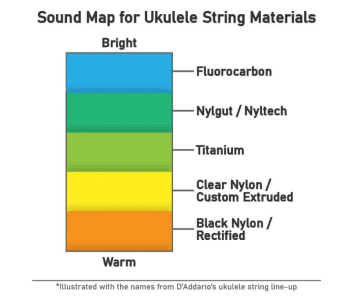Introduction | Understanding the Importance of Ukulele Strings
When it comes to playing the ukulele, many factors contribute to the quality of sound you can produce—your technique, the quality of your instrument, and, of course, the strings. Ukulele strings are often overlooked, yet they play an absolutely crucial role in shaping the instrument’s tone and overall playing experience. The right choice of strings can make a world of difference, affecting everything from sound clarity to ease of play.
For beginners, the vast variety of ukulele strings available might feel overwhelming, but understanding the science behind these strings can guide you toward making the best decision. The material of the strings, their gauge, and tension all influence how your ukulele sounds and feels. Whether you’re strumming in a casual setting or performing in front of an audience, your strings will shape your musical output.
In this guide, we will break down the different types of ukulele strings, explore their characteristics, and help you make an informed decision about which strings suit your style of play best. Whether you’re a beginner or a seasoned player, selecting the perfect strings is an essential step in ensuring your ukulele sounds its best.
The Anatomy of Ukulele Strings
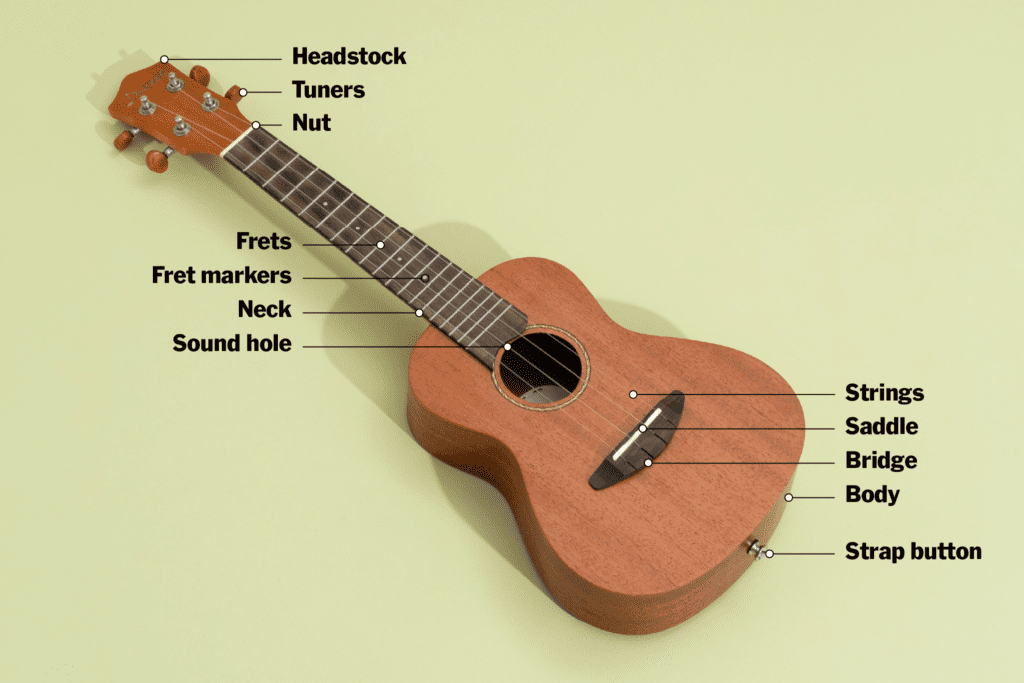
What Makes Up a Ukulele String?
At first glance, ukulele strings might seem simple: just thin, stretched lines of material. But the truth is, the strings on your ukulele are carefully engineered with specific components that influence not only their durability but also their tone. There are three main factors to consider when looking at ukulele strings: material, tension, and gauge.
Material
The material used to make the string is one of the most important factors in determining the overall tone. Each material, such as nylon, fluorocarbon, steel, or titanium, offers different tonal qualities, from mellow and warm to bright and sharp. The material also affects durability, playability, and the tension of the string.
Tension
The tension of a string refers to how tight it is when tuned to pitch. Higher tension means the string is pulled tighter, producing a sharper, brighter sound. Conversely, lower tension results in a softer, mellower tone. The tension of the strings is crucial for both the feel of the ukulele and the tone it produces.
Gauge
The gauge refers to the thickness of the string. Thicker strings tend to produce a fuller, warmer sound, while thinner strings create a brighter, sharper tone. Gauge affects how easily the strings are pressed and how much tension is required to tune the ukulele.
By understanding how these elements interact, you can start to appreciate how much thought goes into selecting the best strings for your ukulele. Whether you’re a beginner learning the ropes or an advanced player seeking a specific sound, knowing the anatomy of ukulele strings will help you make a more informed choice.
How Do Strings Impact Tone?
The most noticeable effect that strings have on a ukulele is on its tone. When you play, the strings vibrate to create sound waves. The material of the string and its tension influence the vibration characteristics, which in turn shape the sound of the ukulele. A string that is too tight may produce a piercing, high-pitched tone, while a string that is too loose may sound flat or muted.
High Tension
Strings with higher tension produce a louder and more defined tone. They allow for a sharper attack, making them ideal for performance situations where volume and clarity are essential. Players who perform in ensembles or play in noisy environments often prefer high-tension strings for their ability to cut through the sound.
Low Tension
Strings with lower tension tend to have a more relaxed and warmer sound. They are often favored by players who enjoy a more laid-back, mellow tone. These strings are easier to press and are often preferred by beginners as they provide a softer feel under the fingers.
Choosing the Right String for Your Style
Your style of playing will greatly influence the type of strings that will work best for you. If you’re just starting, you may find nylon strings more comfortable because they’re easier on the fingers and create a soft, gentle sound. As you progress, you may want to experiment with fluorocarbon or steel strings, which produce brighter, crisper tones. Fluorocarbon strings, for example, are known for their durability and clear tone, making them perfect for solo playing or fingerpicking.
Consider the genre of music you play. If you’re playing traditional Hawaiian songs, you’ll likely prefer nylon strings, which complement the warm, rich tones of this genre. On the other hand, if you’re playing more contemporary music, you might lean towards fluorocarbon or steel strings, as they produce a tone that cuts through other instruments in a mix.
Ultimately, the choice of strings comes down to your personal preference, playing style, and musical goals. Understanding the anatomy and characteristics of the strings will ensure that you choose the best set for your ukulele, leading to a more enjoyable and satisfying playing experience.
Ukulele strings are available in a variety of materials, each offering unique tonal qualities, playability, and durability. The material you choose for your ukulele strings will greatly affect the overall sound, comfort, and longevity of the instrument. Let’s dive deeper into the most popular string materials to help you understand how they impact your ukulele’s performance and tone.
Nylon Strings
Nylon strings are the most traditional and widely used type of string material for ukuleles. These strings are made from synthetic polymers and are popular for their mellow, warm tone. Their smooth surface allows for comfortable playing, which is why they’re often recommended for beginners.
Tone: Nylon strings provide a rich, mellow sound that is perfect for playing traditional Hawaiian music. The warmth they produce enhances the resonance of the ukulele, making it ideal for softer strumming and chord progressions. For many players, this warmth is a defining characteristic of the ukulele’s sound.
Advantages: The biggest benefit of nylon strings is their softness and ease of play. Beginners find them easier on the fingers compared to other materials, as they don’t require as much finger pressure. Nylon strings are also relatively inexpensive and easy to replace.
Disadvantages: One of the downsides of nylon strings is that they can lose their tone quality over time, especially when exposed to environmental factors like humidity. They may also stretch more than other materials, requiring frequent tuning adjustments.
Best For: Beginners, traditional Hawaiian music, acoustic players who prefer a mellow tone, and casual players who want comfortable, easy-to-play strings.
Fluorocarbon Strings
Fluorocarbon strings are made from a synthetic material known for its durability and high-performance qualities. These strings have quickly gained popularity among ukulele players of all skill levels for their clarity, bright sound, and excellent tuning stability.
Tone: Fluorocarbon strings offer a brighter, more focused tone compared to nylon. They produce a crisp, clear sound with great note definition, making them an excellent choice for players who need precise articulation in their playing. Fluorocarbon strings tend to retain their tone much longer than nylon strings, even under fluctuating humidity conditions.
Advantages: Fluorocarbon strings are less prone to stretching and offer more tuning stability than nylon strings. They are also highly resistant to changes in temperature and humidity, making them more durable in varying climates. The tone is brighter and clearer, which is great for players who want to stand out in a performance setting.
Disadvantages: Fluorocarbon strings can feel a bit stiffer than nylon strings, which may make them harder to press down for beginners. Additionally, they are usually more expensive than nylon strings, making them a higher investment for players.
Best For: Intermediate to advanced players, contemporary music genres, solo performances, and anyone who needs a clear, bright sound with consistent tuning.
Steel Strings
Steel strings are typically used in the construction of steel-string ukuleles or guitars, and they offer a louder, brighter sound compared to nylon and fluorocarbon strings. These strings are made from a metal alloy and are designed for ukuleles that require higher tension.
Tone: Steel strings produce a sharp, bright, and loud tone with a lot of projection. They’re ideal for playing in larger ensembles or situations where volume is necessary. Steel strings create a crisp, defined attack and are capable of handling high levels of tension without losing their tone quality.
Advantages: Steel strings are extremely durable and can withstand years of use without losing their integrity. The louder and more focused sound they produce makes them a great choice for performers who need their instrument to project in a crowded environment or on stage.
Disadvantages: The tension in steel strings can be high, which may make them more difficult to play for beginners. They can also be harder on the fingers compared to nylon or fluorocarbon strings, especially during extended play sessions. Additionally, steel strings tend to be more expensive.
Best For: Advanced players, live performers, and those seeking a bright, loud sound that stands out in an ensemble or on stage.
Titanium Strings
Titanium strings are relatively new on the ukulele market, but they’re quickly gaining recognition for their incredible durability and tonal quality. Made from a special titanium alloy, these strings are stronger than both steel and nylon, offering superior tension and a powerful sound.
Tone: Titanium strings produce a bright, clear, and resonant tone with remarkable sustain. They have a unique combination of sharp attack and full-bodied warmth, making them versatile for a wide range of musical styles. The sound is slightly more metallic than that of fluorocarbon, which can add a distinct edge to your playing.
Advantages: Titanium strings are incredibly durable and offer consistent tuning stability. They hold their pitch well, even under varying environmental conditions. Additionally, their strong build allows for high tension, producing a more vibrant and rich tone. They’re less prone to breaking than other types of strings and can withstand aggressive playing styles.
Disadvantages: Titanium strings can be expensive, making them a less accessible option for beginners or players on a budget. They also require more finger pressure to press down, which might make them less comfortable for new players.
Best For: Serious musicians, advanced players, long-lasting durability, and those looking for a vibrant, clear sound with excellent sustain.
How Ukulele Strings Affect Sound
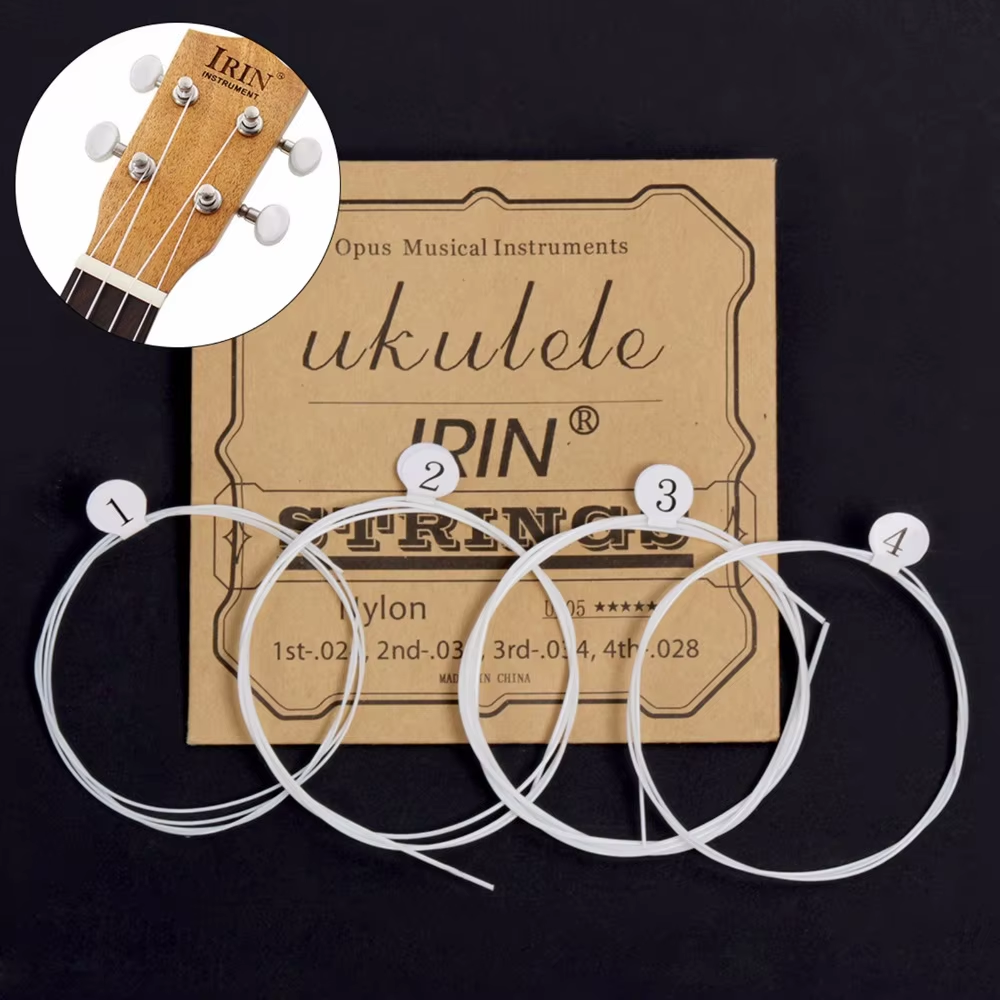
Choosing the right string material will have a significant impact on your ukulele’s sound. Let’s break down how each material influences tone, pitch, and playability.
Nylon Strings and Their Warmth
Nylon strings offer a smooth, mellow tone that is perfect for more traditional ukulele styles, such as Hawaiian music. Their ability to produce soft, rounded sounds makes them a favorite among players who enjoy slow strumming and gentle melodies. Nylon strings tend to be forgiving, offering a warm backdrop for vocals or other instruments.
Nylon strings are also easier on the fingers, providing a comfortable playing experience for beginners. The sound they produce is ideal for relaxed, easy-going performances. However, if you’re looking for a brighter, more cutting sound, nylon strings may not provide the sharpness you need.
Fluorocarbon for Clarity and Brightness
Fluorocarbon strings provide a vibrant and articulate sound that is well-suited for modern music genres. These strings emphasize clarity, making individual notes more distinct. The bright sound of fluorocarbon strings is perfect for players who focus on precision, fingerpicking, or playing solo pieces.
The durability of fluorocarbon strings also makes them great for frequent players. They hold their tone much longer than nylon strings, so you can rely on them to stay in tune and sound great for extended periods of time.
Steel and Titanium for Projection and Durability
Steel and titanium strings produce sounds that are loud, sharp, and highly resonant. These strings are often chosen for their ability to project sound in performance settings, especially in noisy environments. Steel strings, with their bright, cutting tone, are ideal for musicians who need their ukulele to be heard clearly over a crowd or in an ensemble.
Titanium strings provide a similar projection with added warmth and sustain, making them a versatile choice for advanced players who want a balance of sharp attack and rich tone. Both steel and titanium strings tend to last longer, making them an investment for players seeking durability and high performance.
Choosing the Right Ukulele Strings for Your Playing Style
Selecting the right set of strings for your ukulele isn’t just about materials and tension; it’s also about aligning the strings with your playing style. Whether you’re a beginner learning basic chords, an intermediate player looking to refine your technique, or an advanced performer seeking maximum projection, the strings you choose will impact how comfortable you feel while playing and how your instrument sounds.
For Beginners: Comfort and Ease of Play
For beginners, comfort is key. Playing the ukulele should feel enjoyable, and the right strings can make learning to play much easier. Nylon strings are a common choice for novice players due to their softness, which reduces finger fatigue and makes pressing the strings less challenging. These strings have a smooth surface, making them easier on the fingers during long practice sessions.
Key Considerations for Beginners:
Softness: Nylon and fluorocarbon strings are the best choices for players who want a comfortable playing experience. Fluorocarbon strings, in particular, tend to hold their shape and tone better than nylon, so they stay in tune longer.
Low Tension: Low-tension strings are gentler to play, reducing the strain on your fingers. Beginners will find these strings less difficult to press down and more forgiving for early learning stages.
For Intermediate Players: Versatility and Clarity
Intermediate players often start experimenting with different musical genres, and as such, they need strings that provide more versatility. Fluorocarbon strings, with their bright and clear tone, are perfect for players who want to improve their tone while still maintaining ease of play. These strings offer a balance between comfort and performance, and their clarity helps distinguish individual notes, especially during fingerpicking or more intricate strumming patterns.
Key Considerations for Intermediate Players:
Bright Tone: Fluorocarbon strings are ideal for those who wish to step beyond the mellow warmth of nylon and explore a more defined, crisp sound.
Tone Stability: As intermediate players often spend more time playing, strings that maintain their tone and tuning stability, such as fluorocarbon, will provide more consistent performance.
For Advanced Players: Projection and Durability
Advanced players who perform in live settings or large groups need strings that can handle high levels of tension and deliver clear, loud sounds that project across the room. Steel or titanium strings are an excellent choice for such players, as they can withstand the rigors of intense play and offer superior volume and clarity.
Key Considerations for Advanced Players:
Durability and Performance: Steel and titanium strings are known for their durability and their ability to maintain consistent sound quality over time.
Loudness and Clarity: These strings are perfect for live performances where a louder, more projecting sound is needed. Titanium strings also offer excellent sustain and rich tones without compromising on brightness.
Factors to Consider When Choosing Ukulele Strings
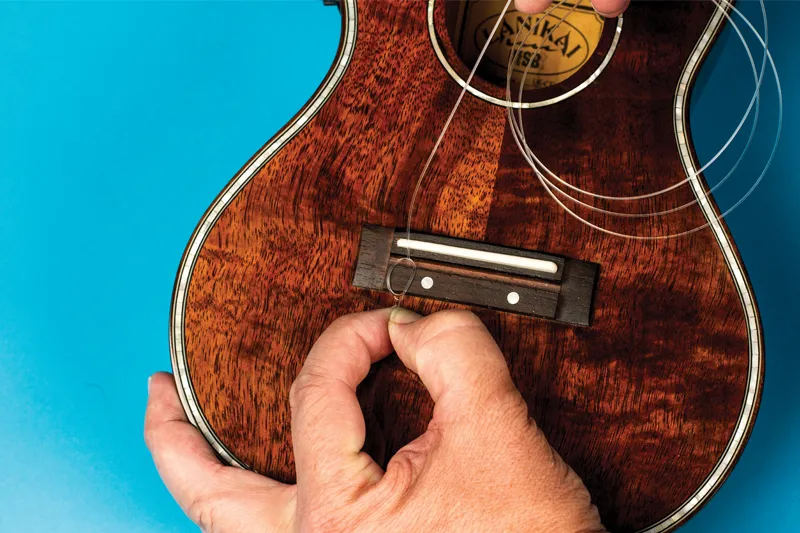
While material is one of the most critical factors in selecting your ukulele strings, several other factors play a role in determining the best set of strings for you. These include the gauge of the string, the ukulele size, the type of music you play, and the climate you live in. Taking all of these into account will help you make a decision that ensures you get the most out of your instrument.
String Gauge and Tension
The gauge refers to the thickness of the strings, and it plays an important role in the overall feel and sound of the ukulele. Thicker strings generally produce a deeper, warmer tone with more sustain, while thinner strings offer a brighter, sharper sound. The tension of the string is another important factor—higher tension means a sharper tone, but also increased difficulty for players who are still developing finger strength.
-
Thicker Strings (Heavy Gauge): Thicker strings produce a warmer, more resonant sound, with better sustain. They are generally favored by players who want a full, rich tone and are willing to exert more pressure to press them down.
-
Thinner Strings (Light Gauge): Lighter strings create a brighter, sharper sound and require less pressure to press down, making them ideal for quick strumming and intricate fingerpicking.
Consider Your Ukulele Size
Ukuleles come in different sizes, and the size of your instrument affects the strings you should choose. Smaller ukuleles, such as soprano ukuleles, typically use lighter strings because they are more responsive to them. Larger ukuleles, like baritones or tenors, may benefit from heavier strings to produce a fuller sound and improve tonal clarity.
-
Small Ukuleles (Soprano and Concert): These require strings that are more flexible, such as lighter gauge nylon or fluorocarbon, to allow for the best tonal balance and ease of play.
-
Large Ukuleles (Tenor and Baritone): Larger instruments tend to need higher tension strings for better sound projection. Steel or titanium strings may be ideal for these ukuleles as they offer durability and brightness.
Climate and Humidity
The climate you live in can also influence the longevity and performance of your strings. Nylon strings, for example, tend to be more sensitive to humidity and temperature changes, which can affect their tuning stability. If you live in an area with extreme humidity or temperature fluctuations, you might want to consider materials like fluorocarbon or titanium, which are much more resistant to these environmental factors.
-
High Humidity: In places with high humidity, fluorocarbon and titanium strings are preferable, as they are more resistant to changes in the environment and will maintain their tuning longer.
-
Dry or Arid Conditions: Nylon strings may be more affected by dryness, which can cause them to lose their flexibility and sound quality faster.
Maintenance and Longevity of Ukulele Strings
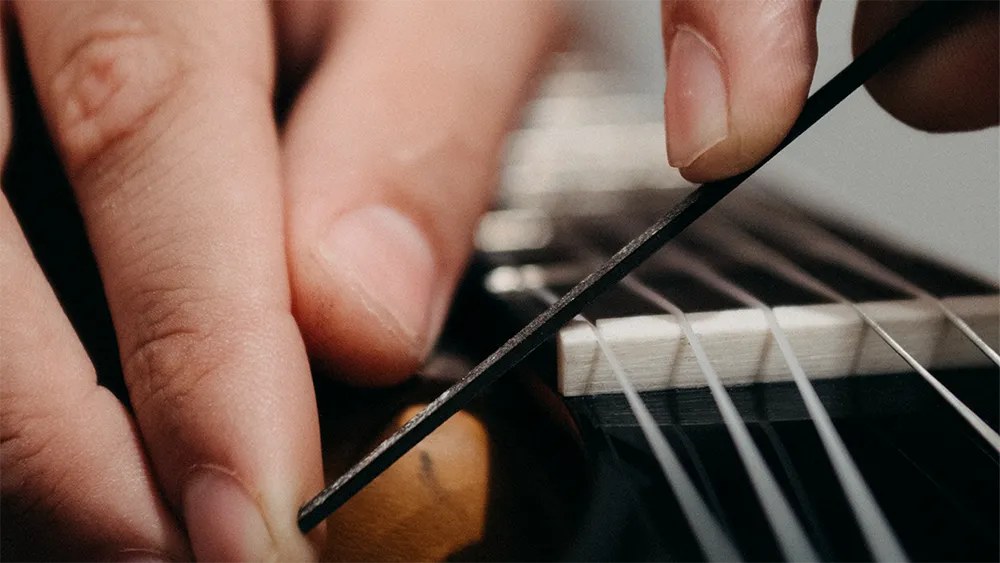
Caring for your ukulele strings is essential to ensure that they last as long as possible and continue to produce a great sound. With the proper maintenance, your strings can retain their tonal quality and playability for a longer period, saving you money and time spent replacing them.
Cleaning Your Strings Regularly
Strings accumulate dirt, oil, and grime from your fingers, especially after prolonged use. This build-up can negatively affect their tone, making them sound dull and muddy. To keep your strings clean, wipe them down after each playing session with a soft cloth to remove any residue. This simple habit can help maintain their brightness and clarity.
After Playing: Use a microfiber cloth to gently wipe down the strings. Avoid harsh chemicals or cleaners, as they can damage the strings and the fretboard.
Before Playing: For a smoother experience, consider applying string lubricant or conditioning products that are safe for ukulele strings.
Proper Tuning and Tension
Regularly tuning your ukulele is essential to maintain string tension and ensure that the strings are neither too tight nor too loose. Over-tightening strings can cause them to break, while strings that are too loose may produce a flat, lifeless tone. Always tune your ukulele before each practice session, and if possible, use a digital tuner to ensure accuracy.
Regular Tuning: Keep your strings at the appropriate tension and avoid leaving them tuned for extended periods when not in use, especially if the ukulele is exposed to fluctuating temperatures or humidity.
Storage: Store your ukulele in a case when not in use, especially if you live in an area with extreme weather conditions. A good case will protect the instrument from sudden changes in temperature and humidity, preventing premature string degradation.
Replacing Strings When Necessary
Eventually, all ukulele strings will need to be replaced. The frequency with which you need to replace your strings depends on how often you play, the material of your strings, and the environmental conditions. For most players, replacing the strings every 6-12 months is a good rule of thumb, though some players may find they need to replace them more often, especially if they perform regularly.
Signs to Replace Strings: If your strings sound muted, lose their tuning stability quickly, or have visible signs of wear (such as fraying or discoloration), it’s time to replace them. Regular players should inspect their strings periodically to ensure they are in good condition.
Conclusion | Finding the Perfect Ukulele Strings for You
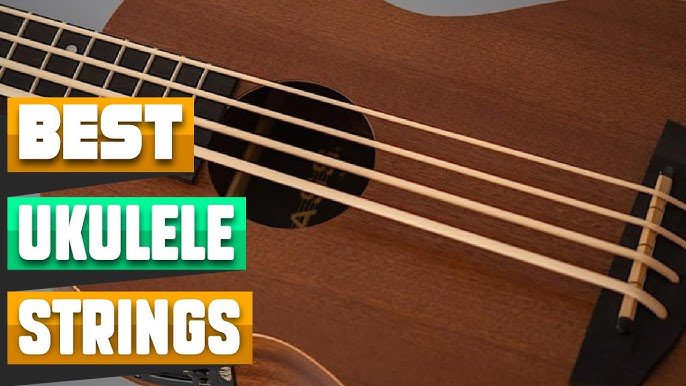
Choosing the right ukulele strings is a deeply personal decision that affects how you experience your instrument. It involves understanding your own playing style, the sound you wish to achieve, and how different string materials can influence that sound. From the softer warmth of nylon to the sharp clarity of fluorocarbon, the options are vast. However, by considering factors such as string gauge, tension, climate, and your ukulele’s size, you can select strings that will best complement your playing habits and environment.
Personal Preference and Experimentation
While there is a wealth of general advice on choosing ukulele strings, it’s important to remember that every player is different. What works well for one player may not be the ideal choice for another. Don’t hesitate to experiment with different types of strings until you find what feels and sounds right for you. In fact, many advanced players regularly experiment with different string types to adapt their sound to different styles and performance needs.
Experiment and Explore: Feel free to try various materials, gauges, and tensions. Each change can significantly alter the tone and playability of your ukulele.
Listen to Your Sound: Pay attention to how the strings impact your ukulele’s tone. A slight change in string type can lead to a huge difference in the final sound you produce.
Investment in Quality Strings
Though the cost of ukulele strings can vary, investing in high-quality strings often pays off in the long run. Quality strings not only sound better but also last longer and contribute to the overall health of your ukulele. Replacing low-quality strings frequently can end up being more costly and frustrating in the long term.
Long-Term Benefits: Good strings enhance the overall tonal quality of your ukulele. Higher-quality strings may seem like a bigger investment upfront, but they will provide better sound and last longer.
Consistency in Play: Top-quality strings maintain their tuning stability, clarity, and comfort for longer periods, making your playing experience more enjoyable.
Wrapping Up: Your Ukulele Strings Journey
Ultimately, the right ukulele strings are a blend of personal preference and practical considerations. Whether you’re strumming at home, playing with friends, or performing on stage, the strings you choose will define the tone and feel of your music. As you continue your musical journey, don’t be afraid to experiment with different options, adjust based on your evolving needs, and make sure to maintain your strings properly for the best sound quality.
Choosing the right strings for your ukulele isn’t just about making your instrument sound good; it’s about finding the strings that make you feel good while playing. Keep exploring the variety of ukulele string materials, gauges, and brands. With this comprehensive guide, you’re now equipped to make an informed decision and tailor your ukulele to your style of music.
If you’re looking to explore more about ukulele techniques or need assistance with your ukulele journey, feel free to check out resources at The Mystic Keys to help you on your way.



